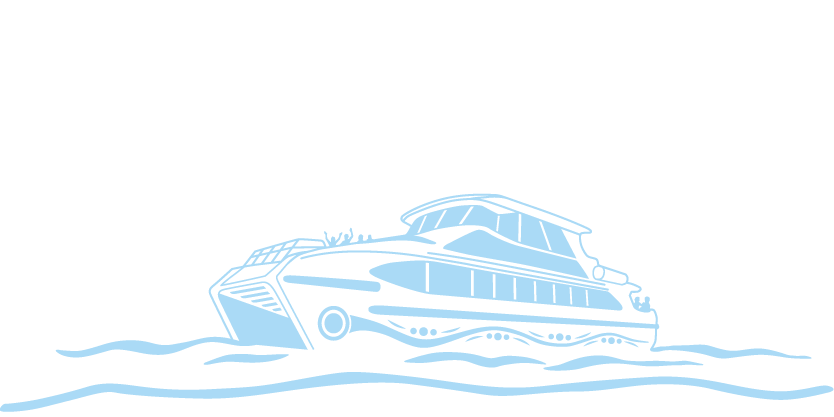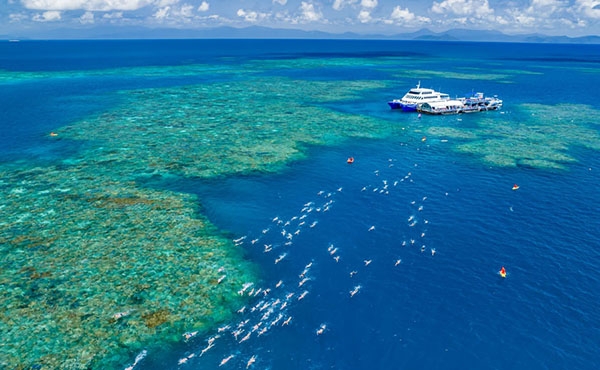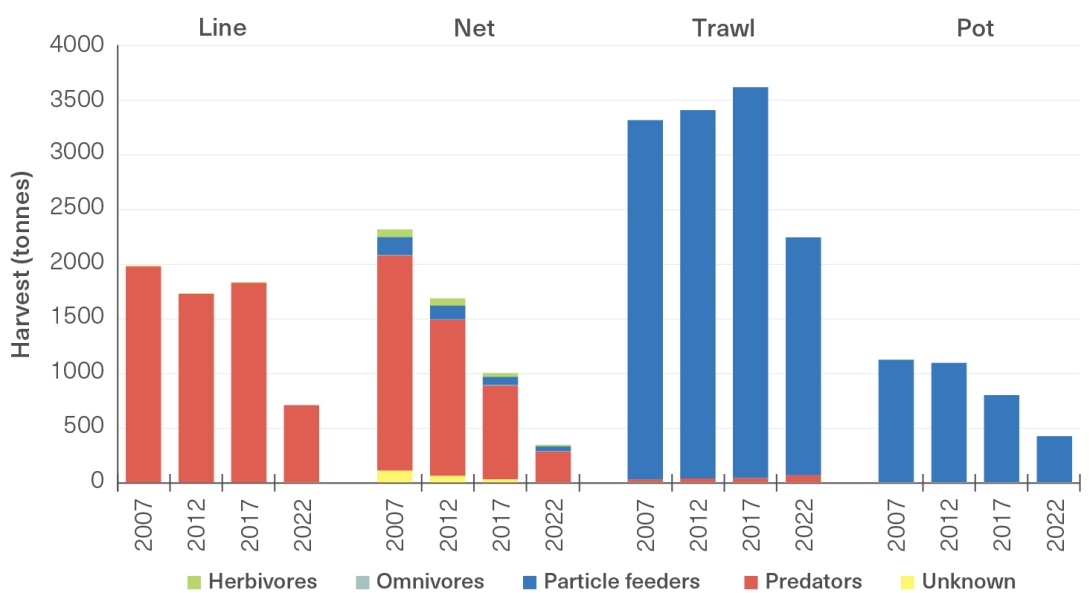3.
Great Barrier Reef Marine Park Authority 2009, Great Barrier Reef Outlook Report 2009, Great Barrier Reef Marine Park Authority, Townsville.
-
407.
Hoel, K., Chin, A. and Lau, J. 2022, Clashing conservation values: the social complexities of shark depredation, Biological Conservation 272: 109658.
437.
Dedini, E., Jacobsen, I. and Zieth, J. 2023, East Coast Otter Trawl Fishery ecological risk assessment species of conservation concern, State of Queensland, Brisbane.
461.
Department of Environment Science and Innovation 2024, 'StrandNet Database'. Unpublished report.
793.
French, S.M. 2023, Stock Assessment of Ballot's saucer scallop (Ylistrum balloti) in Queensland, Australia, with data to October 2022, State of Queensland, Brisbane.
817.
McClure, E.C., Richardson, L.E., Graba-Landry, A., Loffler, Z., Russ, G.R., et al. 2019, Cross-shelf differences in the response of herbivorous fish assemblages to severe environmental disturbances, Diversity 11(2): 23.
839.
Mitchell, J.D., Drymon, J.M., Vardon, J., Coulson, P.G., Simpfendorfer, C.A., et al. 2023, Shark depredation: future directions in research and management, Reviews in Fish Biology and Fisheries 33(2): 475-499.
842.
Mitchell, J.D., McLean, D.L., Collin, S.P. and Langlois, T.J. 2018, Shark depredation in commercial and recreational fisheries, Reviews in Fish Biology and Fisheries 28: 715-748.
1223.
Webley, J., McInnes, K., Teixeira, D., Lawson, A. and Quinn, R. 2015, Statewide recreational fishing survey 2013-14, State of Queensland, Brisbane.
1224.
Department of Agriculture and Fisheries 2023, Queensland Boat Ramp Surveys Dashboard, Queensland Government.
1225.
Department of Agriculture and Fisheries 2023, Queensland Recreational Fishing Surveys Dashboard, Queensland Government.
1237.
Dedini, E. and Jacobsen, I. 2023, East Coast Otter Trawl Fishery Scoping Study, State of Queensland, Brisbane.
1238.
Pitcher, C.R., Rochester, W., Dunning, M., Courtney, T., Broadhurst, M., et al. 2018, Putting potential environmental risk of Australia's trawl fisheries in landscape perspective: exposure of seabed assemblages to trawling, and inclusion in closures and reserves, FRDC Project No 2016-039, CSIRO Oceans & Atmosphere, Brisbane.
1240.
Lovett, R.A., Fox, A.R., Wickens, M.E. and Hillcoat, K.B. 2023, Stock assessment of Queensland east coast tiger prawns (Penaeus esculentus and Penaeus semisulcatus), Australia, with data to December 2021, State of Queensland, Brisbane.
1251.
Department of Agriculture and Fisheries 2017, Queensland Sustainable Fisheries Strategy 2017-2027, State of Queensland, Brisbane.
1254.
Leigh, G.M., Janes, R., Williams, S.M. and Martin, T. 2022, Stock Assessment of Queensland East Coast black jewfish (Protonibea diacanthus), Australia, with data to December 2021, State of Queensland, Brisbane.
1256.
Tanimoto, M., Fox, A.R., O'Neill, M.F. and Langstreth, J.C. 2021, Stock assessment of Australian east coast Spanish mackerel (Scomberomorus commerson), State of Queensland, Brisbane.
1257.
Roelofs, A., Langstreth, J., Lewis, P., Butler, I., Stewart, J. and Grubert, M. 2021, Spanish Mackerel Scomberomorus commerson, in Status of Australian fish stocks reports 2020, eds T. Piddcocke, C. Ashby, K. Hartmann, A. Hesp, P. Hone, et al., Fisheries Research and Development Corporation, Canberra.
1261.
Fowler, A., Stewart, J., Victorian Fisheries Authority, Roelofs, A., Garland, A. and Jackson, G. 2021, Snapper Chrysophrys auratus, in Status of Australian fish stocks reports 2020, eds T. Piddcocke, C. Ashby, K. Hartmann, A. Hesp, P. Hone, et al., Fisheries Research and Development Corporation, Canberra.
1265.
Lovett, R., Northrop, A. and Stewart, J. 2022, Stock assessment of Australian pearl perch (Glaucosoma scapulare) with data to December 2019, State of Queensland, Brisbane.
1276.
Campbell, A.B., Fox, A.R., Hillcoat, K.B. and Sumpter, L. 2021, Stock assessment of Queensland east coast saddletail snapper (Lutjanus malabaricus), Australia, State of Queensland, Brisbane.
-
-
1326.
Piddcocke, T., Ashby, C., Hartman, K., Hesp, A., Hone, P., Klemke, J., Mayfield, S., Roelofs, A., Saunders, T., Stewart, J., Wise, B. and Woodhams, J. 2021, Status of Australian fish stocks reports 2020, Fisheries Research and Development Corporation, Canberra.
1327.
Department of Agriculture and Fisheries 2018, Fisheries data validation plan: Improvement in the accuracy and timeliness of commercial catch and effort information, Queensland Government, Brisbane.
1328.
Department of Agriculture and Fisheries 2023, Fisheries data validation plan: Status update 2023, Queensland Government, Brisbane.
1329.
Rasher, D.B., Hoey, A.S. and Hay, M.E. 2013, Consumer diversity interacts with prey defenses to drive ecosystem function, Ecology 94(6): 1347-1358.
1330.
Rizzari, J.R., Frisch, A.J., Hoey, A.S. and McCormick, M.I. 2014, Not worth the risk: apex predators suppress herbivory on coral reefs, Oikos 123(7): 829-836.
1331.
Boaden, A.E. and Kingsford, M.J. 2015, Predators drive community structure in coral reef fish assemblages, Ecosphere 6(4): 1-33.
1332.
Rigby, C.L., White, W.T. and Simpfendorfer, C.A. 2016, Deepwater chondrichthyan bycatch of the eastern king prawn fishery in the southern Great Barrier Reef, Australia, PLoS One 11(5): e0156036.
1333.
Tobin, A.J., Simpfendorfer, C.A., Mapleston, A., Currey-Randall, L.M., Harry, A.V., et al. 2010, A quantitative ecological risk assessment of sharks and finfish of the Great Barrier Reef World Heritage Area inshore waters: a tool for fisheries and Marine Park managers. Identifying species at risk and potential mitigation strategies, Marine and Tropical Sciences Research Facility, Cairns.
1334.
Harry, A.V., Saunders, R.J., Smart, J., J.S., Yates, P.M., et al. 2016, Assessment of a data-limited, multi-species shark fishery in the Great Barrier Reef Marine Park and south-east Queensland, Fisheries Research 177: 104-115.
1335.
Campbell, M.J., Courtney, A.J., Wang, N., McLennan, M.F. and Zhou, S. 2017, Estimating the impacts of management changes on bycatch reduction and sustainability of high-risk bycatch species in the Queensland East Coast Otter Trawl Fishery. FRDC Final Report Project number 2015/014, Fisheries Research and Development Corporation, Brisbane.
1336.
Pears, R.J., Morison, A.K., Jebreen, E.J., Dunning, M.C., Pitcher, C.R., et al. 2012, Ecological risk assessment of the East Coast Otter Trawl Fishery in the Great Barrier Reef Marine Park: Data Report, Great Barrier Reef Marine Park Authority, Townsville.
1337.
Ellis, J.R., McCully Phillips, S.R. and Poisson, F. 2017, A review of capture and post-release mortality of elasmobranchs, Journal of Fish Biology 90(3): 653-722.
1338.
Campbell, M.J., McLennan, M.F., Courtney, A.J. and Simpfendorfer, C.A. 2018, Post-release survival of two elasmobranchs, the eastern shovelnose ray (Aptychotrema rostrata) and the common stingaree (Trygonoptera testacea), discarded from a prawn trawl fishery in southern Queensland, Australia, Marine and Freshwater Research 69(4): 551-561.
1339.
Adams, K.R., Fetterplace, L.C., Davis, A.R., Taylor, M.D. and Knott, N.A. 2018, Sharks, rays and abortion: The prevalence of capture-induced parturition in elasmobranchs, Biological Conservation 217: 11-27.
1340.
Wilson, S.M., Raby, G.D., Burnett, N.J., Hinch, S.G. and Cooke, S.J. 2014, Looking beyond the mortality of bycatch: sublethal effects of incidental capture on marine animals, Biological Conservation 171: 61-72.
1341.
Wang, N.H., Courtney, A.J., Campbell, M.J. and Yang, W. 2020, Quantifying long-term discards from Queensland’s (Australia) East Coast Otter Trawl fishery, ICES Journal of Marine Science 77(2): 680-691.
1342.
Cooke, S.J. and Schramm, H.L. 2007, Catch‐and‐release science and its application to conservation and management of recreational fisheries, Fisheries Management and Ecology 14(2): 73-79.
1343.
Raby, G.D., Messmer, V., Tobin, A.J., Hoey, A.S., Jutfelt, F., et al. 2018, Swim for it: effects of simulated fisheries capture on the post-release behaviour of four Great Barrier Reef fishes, Fisheries Research 206: 129-137.
1345.
Thurstan, R.H., Buckley, S.M. and Pandolfi, J.M. 2018, Trends and transitions observed in an iconic recreational fishery across 140 years, Global Environmental Change 52: 22-36.
1346.
Cooke, S.J., Venturelli, P., Twardek, W.M., Lennox, R.J., Brownscombe, J.W., et al. 2021, Technological innovations in the recreational fishing sector: implications for fisheries management and policy, Reviews in Fish Biology and Fisheries 31(2): 253-288.
1344.
Brown, C.J. 2016, Social, economic and environmental effects of closing commercial fisheries to enhance recreational fishing, Marine Policy 73: 204-209.
1347.
Mitchell, J.D. 2022, Discussion paper for the Fisheries Research & Development Corporation national workshop on shark depredation in Australian fisheries, Fisheries Research and Development Corporation, Brisbane.
1348.
Piddocke, T., Mitchell, J. and Izzo, C. 2021, Shark depredation in Australian fisheries. Understanding the scope of the issue and identify potential mitigation options: workshop summary. FRDC Final Report Project number FRDC2021-038, Fisheries Research and Development Corporation, Brisbane.
1349.
Jacobsen, I., Walton, L. and Lawson, A. 2021, East Coast Inshore Large Mesh Net Fishery Level 2 Ecological Risk Assessment [Species of Conservation Concern], State of Queensland, Brisbane.
1350.
Dulvy, N.K., Pacoureau, N., Rigby, C.L., Pollom, R.A., Jabado, R.W., et al. 2021, Overfishing drives over one-third of all sharks and rays toward a global extinction crisis, Current Biology 31(21): 4773-4787.
1351.
Department of the Environment and Energy 2017, Recovery Plan for Marine Turtles in Australia 2017-2027, Commonwealth of Australia, Canberra.
1352.
Parra, G.J. and Cagnazzi, D. 2016, Conservation status of the Australian humpback dolphin (Sousa sahulensis) using the IUCN Red List Criteria, Advances in Marine Biology 73: 157-192.
1353.
Cagnazzi, D. 2010, Conservation Status of Australian Snubfin Dolphin, Orcaella heinsohni, and Indo-Pacific Humpback Dolphin, Sousa chinensis, in the Capricorn Coast, Central Queensland, Australia, Dissertation/Thesis, Thesis, Southern Cross University.
-
1355.
Riskas, K.A., Fuentes, M.M.P.B. and Hamann, M. 2016, Justifying the need for collaborative management of fisheries bycatch: A lesson from marine turtles in Australia, Biological Conservation 196: 40-47.
1356.
Lucas, P.H.C., Webb, T., Valentine, P.S. and Marsh, H. 1997, The Outstanding Universal Value of the Great Barrier Reef World Heritage Area, Great Barrier Reef Marine Park Authority, Townsville.
1357.
Harrison, H.B., Drane, L., Berumen, M.L., Cresswell, B.J., Evans, R.D., et al. 2023, Ageing of juvenile coral grouper (Plectropomus maculatus) reveals year-round spawning and recruitment: implications for seasonal closures, Proceedings of the Royal Society B: Biological Sciences 290(2001): 20230584.
1358.
Tobin, A., Heupel, M., Simpfendorfer, C., Buckley, S., Thurstan, R., et al. 2014, Utilising innovative technology to better understand Spanish mackerel spawning aggregations and the protection offered by Marine Protected Areas. FRDC Project No 2010/007, Centre for Sustainable Tropical Fisheries and Aquaculture, James Cook University.
1359.
Buckley, S.M., Thurstan, R.H., Tobin, A. and Pandolfi, J.M. 2017, Historical spatial reconstruction of a spawning-aggregation fishery, Conservation Biology 31(6): 1322-1332.
1360.
de Mitcheson, Y.S. 2016, Mainstreaming fish spawning aggregations into fishery management calls for a precautionary approach, Bioscience 66(4): 295-306.
1361.
Lamb, J.B., Williamson, D.H., Russ, G.R. and Willis, B.L. 2015, Protected areas mitigate diseases of reef-building corals by reducing damage from fishing, Ecology 96(9): 2555-2567.
1362.
Great Barrier Reef Marine Park Authority 2023, Field Management Compliance Unit, Unpublished analysis for Great Barrier Reef Marine Park Authority, Townsville.
1363.
Weekers, D.P. and Zahnow, R. Risky facilities: Analysis of illegal recreational fishing in the Great Barrier Reef Marine Park, Australia, Australian & New Zealand Journal of Criminology 52(3): 368-389.
1364.
Bergseth, B.J., Williamson, D.H., Russ, G.R., Sutton, S.G. and Cinner, J.E. 2017, A social-ecological approach to assessing and managing poaching by recreational fishers, Frontiers in Ecology and the Environment 15(2): 67-73.
1365.
Weekers, D., Petrossian, G. and Thiault, L. 2021, Illegal fishing and compliance management in marine protected areas: a situational approach, Crime Science 10(1): 9.
1366.
Castro-Sanguino, C., Bozec, Y.M., Dempsey, A., Samaniego, B.R., Lubarsky, K., et al. 2017, Detecting conservation benefits of marine reserves on remote reefs of the northern GBR, PLoS ONE 12(11): e0186146.
1367.
Little, L.R., Smith, A.D.M., McDonald, A.D., Punt, A.E., Mapstone, B.D., et al. 2005, Effects of size and fragmentation of marine reserves and fisher infringement on the catch and biomass of coral trout (Plectropomus leopardus) on the Great Barrier Reef, Fisheries Management and Ecology 12(3): 177-188.



